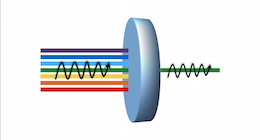Home > Research Teams > Dynamics and Interactions: Radiation, Atoms and Molecules (DIRAM) > Coherence and control of quantum processes
Coherence and control of quantum processes
Coherence and control of quantum processes
Eric Charron, Osman Atabek, Fabien Gatti, Arne Keller (LPMQ since 01/01/2017)

- Dense vapor of quantum emitters (blue disk) interacting with an incident electromagnetic field. We have shown that strong dipole-dipole interactions between the quantum emitters can be used to manipulate light scattering and turn opaque objects transparent at a given frequency (read more here)
The production of ultra-short optical pulses has opened an exciting new chapter for the study of atomic and molecular dynamics. It is now possible to generate laser pulses with a duration ranging from a few tens of attoseconds to a few tens of femtoseconds and whose spectral content, phase distribution and temporal envelope can be controlled experimentally.
These pulses allow for example to monitor the temporal evolution of electronic and nuclear wave packets. This opens the way to a better understanding of the dynamics and reaction mechanisms occurring in atomic and/or molecular excited systems.
Beyond the analysis of various dynamical processes, these "flashes of light" can also be used to control the atomic and molecular dynamics by inducing a form of selectivity when different quantum channels come in competition. For this purpose of quantum selectivity, the preservation and control of quantum coherence are key objectives.
Within the DIRAM research group, we are studying the coherence of fundamental quantum systems such as atoms and molecules using time-dependent quantum mechanics, in order to control their response.
Fano goes Nano
Fano Interferences occur when a quantum system can follow two pathways to its fragmentation.
In an article to appear in Physical Review Letters Daniel Finkelstein-Shapiro has revisited this fundamental phenomenon in the framework of an international collaboration bringing together researchers from Laboratoire de Chimie Théorique of the Université Pierre et Marie Curie, from the Department of Chemistry and Biochemistry Chemistry Département of the Arizona State University and from ISMO.


